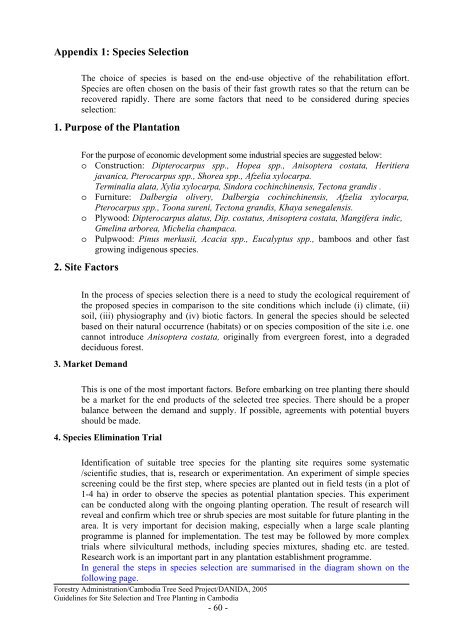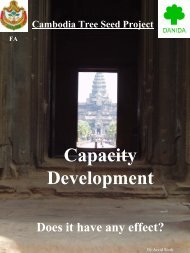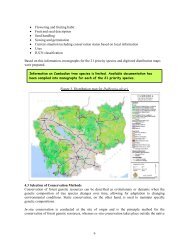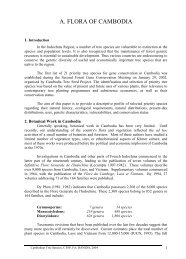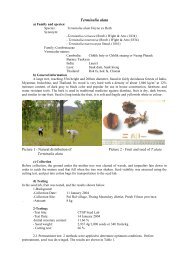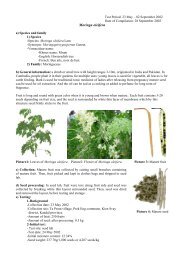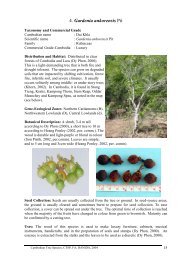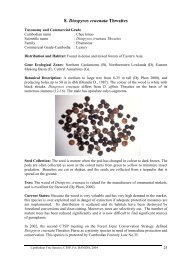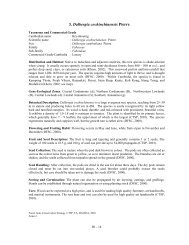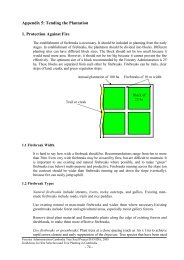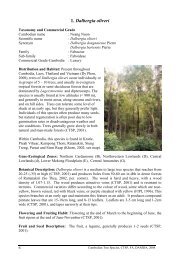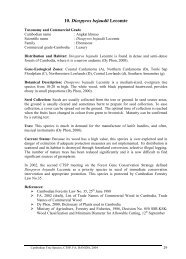Species Selection - Cambodia Tree Seed Project
Species Selection - Cambodia Tree Seed Project
Species Selection - Cambodia Tree Seed Project
Create successful ePaper yourself
Turn your PDF publications into a flip-book with our unique Google optimized e-Paper software.
Appendix 1: <strong>Species</strong> <strong>Selection</strong><br />
The choice of species is based on the end-use objective of the rehabilitation effort.<br />
<strong>Species</strong> are often chosen on the basis of their fast growth rates so that the return can be<br />
recovered rapidly. There are some factors that need to be considered during species<br />
selection:<br />
1. Purpose of the Plantation<br />
For the purpose of economic development some industrial species are suggested below:<br />
o Construction: Dipterocarpus spp., Hopea spp., Anisoptera costata, Heritiera<br />
javanica, Pterocarpus spp., Shorea spp., Afzelia xylocarpa.<br />
Terminalia alata, Xylia xylocarpa, Sindora cochinchinensis, Tectona grandis .<br />
o Furniture: Dalbergia olivery, Dalbergia cochinchinensis, Afzelia xylocarpa,<br />
Pterocarpus spp., Toona sureni, Tectona grandis, Khaya senegalensis.<br />
o Plywood: Dipterocarpus alatus, Dip. costatus, Anisoptera costata, Mangifera indic,<br />
Gmelina arborea, Michelia champaca.<br />
o Pulpwood: Pinus merkusii, Acacia spp., Eucalyptus spp., bamboos and other fast<br />
growing indigenous species.<br />
2. Site Factors<br />
In the process of species selection there is a need to study the ecological requirement of<br />
the proposed species in comparison to the site conditions which include (i) climate, (ii)<br />
soil, (iii) physiography and (iv) biotic factors. In general the species should be selected<br />
based on their natural occurrence (habitats) or on species composition of the site i.e. one<br />
cannot introduce Anisoptera costata, originally from evergreen forest, into a degraded<br />
deciduous forest.<br />
3. Market Demand<br />
This is one of the most important factors. Before embarking on tree planting there should<br />
be a market for the end products of the selected tree species. There should be a proper<br />
balance between the demand and supply. If possible, agreements with potential buyers<br />
should be made.<br />
4. <strong>Species</strong> Elimination Trial<br />
Identification of suitable tree species for the planting site requires some systematic<br />
/scientific studies, that is, research or experimentation. An experiment of simple species<br />
screening could be the first step, where species are planted out in field tests (in a plot of<br />
1-4 ha) in order to observe the species as potential plantation species. This experiment<br />
can be conducted along with the ongoing planting operation. The result of research will<br />
reveal and confirm which tree or shrub species are most suitable for future planting in the<br />
area. It is very important for decision making, especially when a large scale planting<br />
programme is planned for implementation. The test may be followed by more complex<br />
trials where silvicultural methods, including species mixtures, shading etc. are tested.<br />
Research work is an important part in any plantation establishment programme.<br />
In general the steps in species selection are summarised in the diagram shown on the<br />
following page.<br />
Forestry Administration/<strong>Cambodia</strong> <strong>Tree</strong> <strong>Seed</strong> <strong>Project</strong>/DANIDA, 2005<br />
Guidelines for Site <strong>Selection</strong> and <strong>Tree</strong> Planting in <strong>Cambodia</strong><br />
- 60 -
Steps in <strong>Selection</strong> of <strong>Tree</strong> <strong>Species</strong> for Planting<br />
Programs<br />
Define an objective<br />
(economic development,<br />
poverty reduction, and<br />
environmental protection<br />
Based on the objective defined<br />
select a group of tree species<br />
One by one, compare the species<br />
requirement with site conditions:<br />
o Soil and topography<br />
o Climate<br />
o Existing vegetation<br />
Based on site conditions<br />
select a group of tree species<br />
(among the first group)<br />
<strong>Species</strong> and or provenance trial<br />
Economic<br />
considerations<br />
<strong>Tree</strong> species for<br />
planting<br />
Forestry Administration/<strong>Cambodia</strong> <strong>Tree</strong> <strong>Seed</strong> <strong>Project</strong>/DANIDA, 2005<br />
Guidelines for Site <strong>Selection</strong> and <strong>Tree</strong> Planting in <strong>Cambodia</strong><br />
- 61 -


